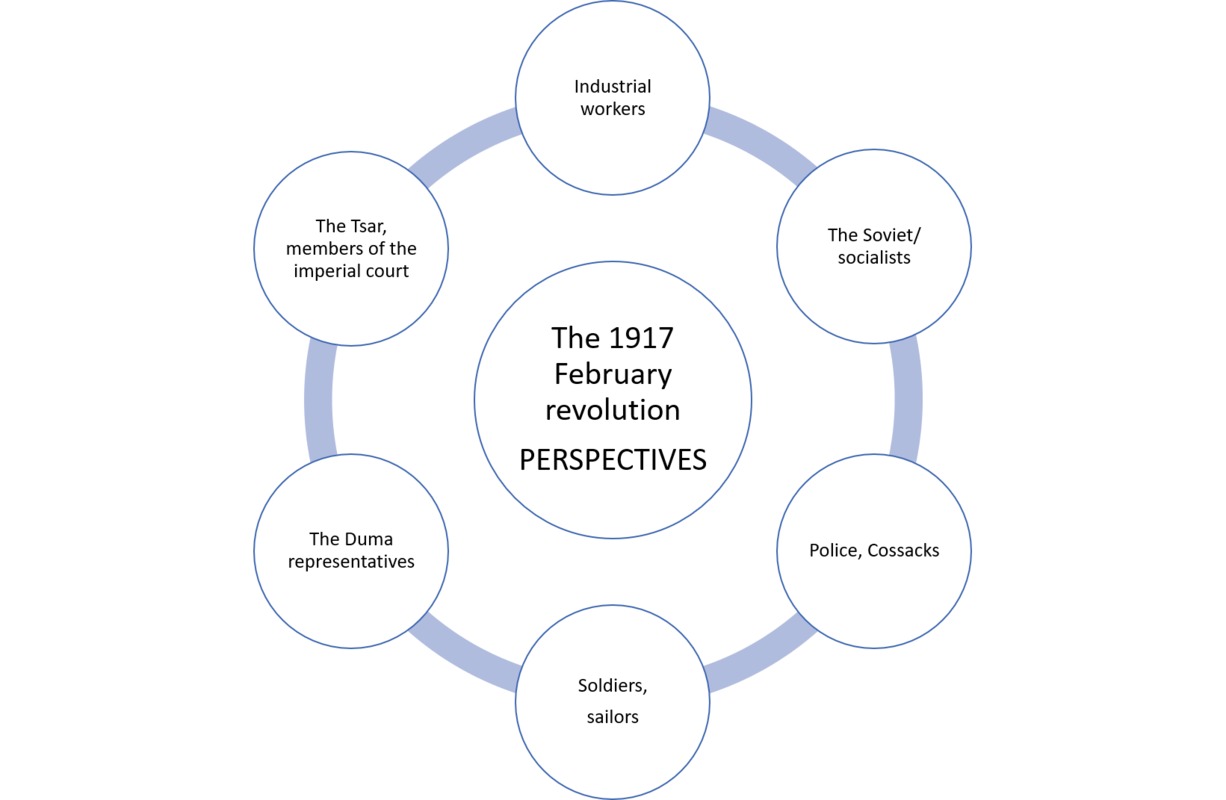The 1917 revolutions
P3 questions on the 1917 revolutions
- Compare and contrast the causes and the consequences of Russian revolutions in 1905 and in February/March 1917.
- "Russia's participation in the First World War was the main cause of the February/March 1917 Revolution." To what extent do you agree with this statement?
- Evaluate the reasons for the overthrow of the Provisional Government in October/November 1917.
- Discuss the view that the Provisional Government collapsed because of the power of the Soviets.
- Compare and contrast the causes of the February/March and October/November Revolutions in 1917.
- Discuss the reasons for the final crisis of autocracy in February/March 1917.
- "Russia's participation in the First World War was the main cause of the February/March 1917 Revolution." To what extent do you agree with this statement?
- Evaluate the reasons for the overthrow of the Provisional Government in October/November 1917.
- Discuss the view that the Provisional Government collapsed because of the power of the Soviets.
- Compare and contrast the causes of the February/March and October/November Revolutions in 1917.
- Discuss the reasons for the final crisis of autocracy in February/March 1917.
The February Revolution - perspectives of the comtemporaries
The February Revolution - problems of interpretation
TASK 3: After studied pages 151-153/185-87 answer to these questions:
2.1. Compare and contrast interpretations made by western and Soviet/communist historians about the causes and the developments of the February 1917 revolution.
2.2. Soviet historians emphasized that the February Revolution was a spontaneous action without organised political leadership. How fair is it to say that this interpretation based more on ideological issues than objective studies with historical sources?
2.1. Compare and contrast interpretations made by western and Soviet/communist historians about the causes and the developments of the February 1917 revolution.
2.2. Soviet historians emphasized that the February Revolution was a spontaneous action without organised political leadership. How fair is it to say that this interpretation based more on ideological issues than objective studies with historical sources?
The Dual Power system
A: the Provisional Government
- The first Provisional Government and its programme
B: the soviets/ the Petrograd Soviet
- made up of Mensheviks and Social Revolutionaries (+ some Bolsheviks)
- peasants, industrial workers and soldiers established own soviets across Russia
- in June the meeting of the first All-Russian Congress of Soviets
TASK 4: What were the strenghts and weaknesses of a) the Provisional Government and b) the Soviet? (pages 153-156/187-191)
> make notes to the table.
> the period of the Dual Power
TASK 5: Make a list about the problems faced by the Dual Power system (pages 156-159/192-195).
- The first Provisional Government and its programme
B: the soviets/ the Petrograd Soviet
- made up of Mensheviks and Social Revolutionaries (+ some Bolsheviks)
- peasants, industrial workers and soldiers established own soviets across Russia
- in June the meeting of the first All-Russian Congress of Soviets
TASK 4: What were the strenghts and weaknesses of a) the Provisional Government and b) the Soviet? (pages 153-156/187-191)
> make notes to the table.
> the period of the Dual Power
TASK 5: Make a list about the problems faced by the Dual Power system (pages 156-159/192-195).
Liitteet:
The October Revolution
* What, according to Lenin's April theses, should be done?
* Compare and contrast the aims and means of the Mensheviks and the Bolsheviks. ( > power point)
* Watch a documentary film from 5:05 until 9:20
Lenin's call to power, 24 October 1917.
* Why was there a second revolution in Russia in 1917?
TASK 6: Compare and contrast Lenin and Trotsky as revolutionary leaders in 1917. < Work with a pair. Take one individual each and create a diagram of facts while reading pages 164 - 169/ 201 - 207.
* Compare and contrast the aims and means of the Mensheviks and the Bolsheviks. ( > power point)
* Watch a documentary film from 5:05 until 9:20
Lenin's call to power, 24 October 1917.
* Why was there a second revolution in Russia in 1917?
TASK 6: Compare and contrast Lenin and Trotsky as revolutionary leaders in 1917. < Work with a pair. Take one individual each and create a diagram of facts while reading pages 164 - 169/ 201 - 207.
Liitteet:
History & TOK
Sergei Eisenstein: The October (1928)
Watch texts at the beginning; 10 min: Lenin arrives to the Finland station; 1:07: The voting; 1:28: Aurora/ The Winter Palace
Hallucinating history: when Stalin and Eisenstein reinvented a revolution
(The Guardian, 24 Oct 2017)
Nicholas II: Russian history re-written
What if Russian revolution had never happened?
Sources
Russian revolution documents (AlphaHistory)
Fordham University source collection
In the Shadow of Red October (BBC)
A century ago, the Bolsheviks seized power in Russia and created the world’s first Marxist state. The dramatic events of 1917 still reverberate. But what legacy of the revolution can be seen in four cities in Vladimir Putin's Russia?
A short biography of V.I. Lenin
(Source: Spartacus Educational)
This content in IB History Syllabus
A) HL (Paper 3) Imperial Russia, revolution and the establishment of the Soviet Union (1855-1924)
Revolutions
B) HL & SL (Paper 2) Authoritarian states
Lenin's rise to power
